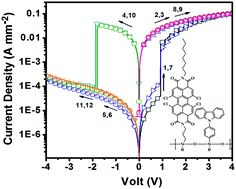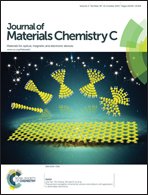The synthesis and flash memory behavior of alternate copolymer containing carbazole donor and perylenediimide derivatives acceptor by the hybridization of organo-silicon†
Abstract
In this study, two new donor–acceptor alternate copolysiloxanes containing carbazole and PDI derivatives pendants (PCzMSi-alt-PDISi and PCzPhSi-alt-PDISi) were prepared. The two copolysiloxanes showed the resistor type memory behavior. The memory devices based on PCzMSi-alt-PDISi and PCzPhSi-alt-PDISi exhibited nonvolatile flash memory characteristics, with an ON/OFF current density ratio of 103 and low threshold voltages (less than 1 V). As far as we know, it is the first nonvolatile flash memory device reported with the lowest threshold voltage based on the copolymer due to high flexibility of Si–O bonds. The conformation change from the regiorandom and regioregular alignments and the charge transfer interactions between pendent carbazole donor and PDI acceptor moieties as well as the unstable CT complex explain their memory characteristics. Our results open a new way to prepare the low-energy cost flash memory devices with the donor–acceptor pendent polysiloxanes.


 Please wait while we load your content...
Please wait while we load your content...